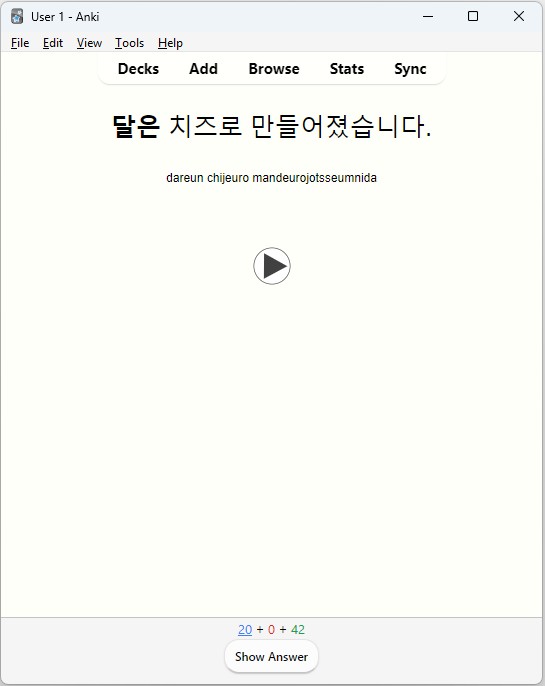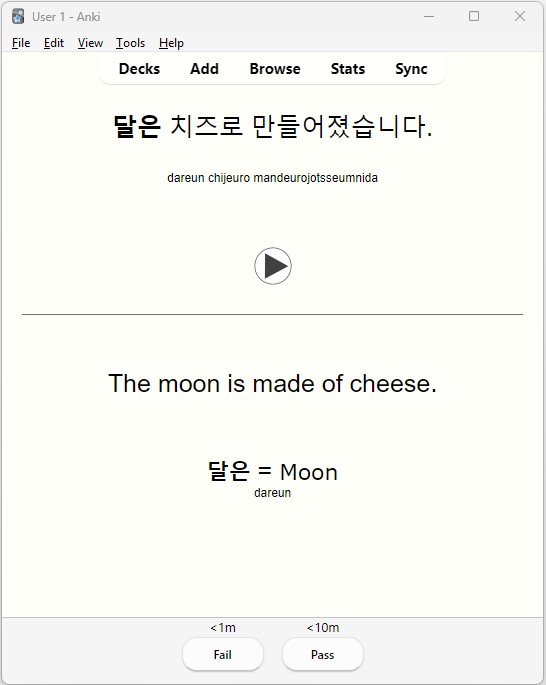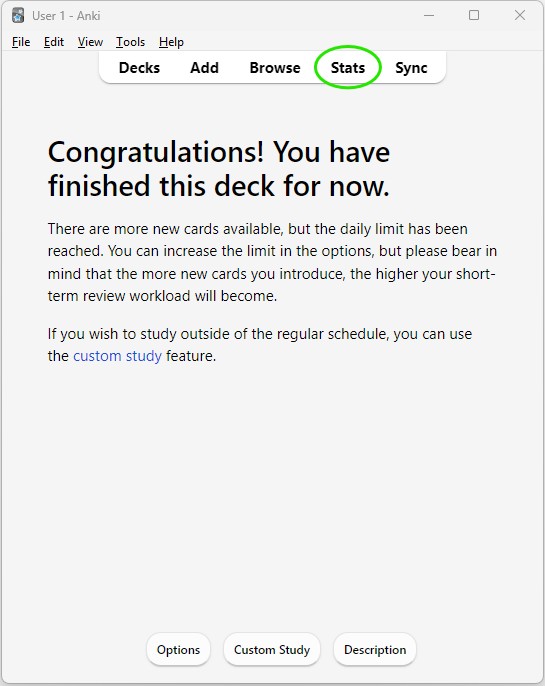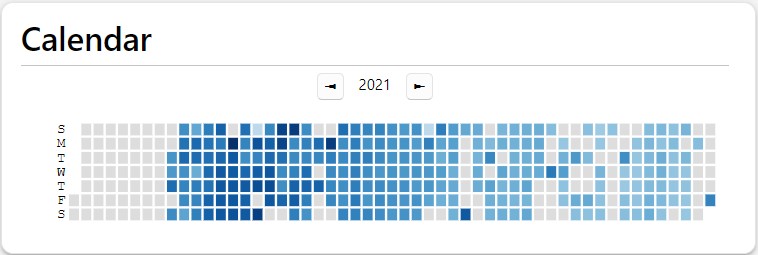How to Study With Anki
We have one final lesson before we are done with the Anki section of this chapter. You've set up Anki, built templates, and created some cards. Now, how do you study those Anki cards? How do you get the benefits out of Anki now that you've put in the work to prepare the program?
Where's the Instruction Manual?
While there's plenty of documentation for setting up Anki, it doesn't really come with any instructions for studying. You have to figure out the best way for you to study, and it might be different from the way I study.
Here are some early tips to keep in mind, and then I'll explain in detail my studying process:
- Consistency is the most important thing.
- Aim to understand, not translate.
- Be honest with grading (pass or fail), so the algorithm will know how to assist you.
- If you never fail, you're not learning anything new.
- If you always fail, you probably need to create better sentences.
ETB Anki Studying Process
From Anki's main window, you'll click into your English deck and then hit the big blue button that says "Study Now".
In the following section, I'm going to be telling you to say things out loud. If you need to be quiet or you're feeling lazy, you can think these things instead of saying them. But I would really encourage you to actually say them during most of your Anki study sessions! Your mouth needs to learn how to form the shapes that produce English sounds.
In my Korean deck, this is the first card that Anki shows me today. We'll use it as an example:

When the card loads on my screen, the audio plays automatically. If yours doesn't play automatically, edit your Deck options and turn off the setting for "Don't play audio automatically".
Step 1. Listen to the audio and read along.
If you're using a transliteration (like I am in my example) because English uses a different written script than your language, read the English script while the audio is playing. This allows your brain to form connections between the audio and the English letters.
Step 2. Read aloud to practice pronunciation.
After the audio finishes, mimic it. Try to say the sounds of the words as you just heard them in the audio. Feel free to replay the audio as many times as you want if there's a part you didn't hear clearly the first time.
Step 3. Say aloud the meaning of the sentence in your own language.
If this is a "new" card, you'll see an underline beneath the blue number at the bottom of the card, like in my example. In this case, just try to guess the meaning. The more English you learn, the better your guesses will become because you'll understand the other words in the sentence, and the context will give you clues. As a beginner, most of these guesses will be wrong, or you'll just have no idea. That's okay to just say "I don't know".
If this is a "review" card, you'll see the underline beneath the red or green numbers. You've seen these cards before, so try to remember what you learned from the last time you saw them.
Step 4. Reveal the answer.
You can click the "Show Answer" button at the bottom of the card, or just press the spacebar on your keyboard. This will show you the back of the card. We formatted our cards to show everything from the front of the card on the back side as well.

This sentence is a reference to an old cartoon called Wallace and Gromit 😊 (it's good immersion content if you want to learn British English!). It's a silly and memorable sentence for me, which makes it perfect for helping me remember this word.
Step 5. Say aloud the English Target Word again.
Now that the answer has been revealed, don't move to the next card just yet! This is the most important part of studying with Anki: the feedback.
Focus on the target word in English and your language for a brief moment. Say both of them out loud one or two times, "달은... moon... moon... 달은... 달은. Okay, got it."
Step 6. Grade the card.
Give yourself a grade of Pass (you can press 2 on your keyboard) or Fail (1 on your keyboard) to tell Anki how you did with the card. This is how you help Anki to help you. We'll talk about this more in a bit.
TIP! If you accidentally give yourself the wrong grade, press CTRL+Z to bring back the card. Anki will say "Answer Card undone", meaning it will forget the grade you gave it previously and allow you to grade it again.
After grading the card, you'll move to the next card. You should probably be spending 10-20 seconds per card; it's a pretty fast process, so don't think about each card too much.
What is a Pass? What is a Fail?
Grading is how we give the Anki algorithm information about when to show us each card again. It's important, so I'll give some examples of answers that pass and answers that fail. We'll use the card from above as the example card.
For Step 3, if I say these answers or similar ones before revealing the back of the card, I'd grade it a Fail:
- The sun is made of cheese.
- I don't know. I have no idea.
- Um...something about cheese.
- We forgot the crackers! (This is another reference to the cartoon)
Now, if I gave one of these answers during Step 3, I would Pass the card:
- The moon is made of cheese. (The exact answer from the back of the card)
- The moon is made out of cheese. (Same meaning)
- The moon is made from cheese. (Same meaning)
- The moon is cheese. (Same meaning)
- Moons are cheese. (Close enough, I remembered the target word)
- The moon is white.
For the last one, I'll be honest, I would hesitate on grading an answer like that as a Pass. However, with that answer, I remembered the target word, which is the goal, so it should be a Pass. I didn't remember the word cheese, which means I should probably make new cards to learn the words "cheese" and "white" too.
Tips on Failing
If you never fail any Anki cards, then you've created cards for vocabulary that you already know. Studying these words is not a very good use of your time. You should be learning NEW vocabulary! ...and if you're learning new vocabulary, you're going to fail cards often.
The entire purpose of Anki for us is to learn, and you can't learn without failing. But you have to fail correctly.
If you get a card wrong, don't just immediately hit the Fail button and move on. You won't learn anything that way. You have to spend a few extra seconds staring at the correct English Sentence, the English Target word, and the Target Word in your language. Say them out loud a couple of times.
There's no need to feel bad about yourself. Remember, failing is the whole point; that's how we learn with Anki. So don't feel bad, but learn from your mistakes.
If you frequently fail a card, eventually it will become a "leech", which you can see in the Browse window of Anki. But even before it becomes a leech, you can edit it by pressing "E" on your keyboard while studying, or you can delete the card with the Delete button on your keyboard.
If a card feels too hard, confusing, boring, annoying, or forgettable, either create a better English Sentence for the card, or just delete it! And don't feel bad about doing it—you're not being a quitter, you're being efficient with your time. You can always create the card again another day when you're ready for it.
Is Anki Working?
After you finish studying all of the cards that you need to study for the day, Anki will say, "Congratulations! You have finished this deck for now." You'll have more cards to study tomorrow.

If you want to check your progress, you can click the Stats tab to see a bunch of graphs. There's a lot in here, but I'll point out some that I think are useful.
Today

Here you can see how much time you spend per card. Faster is not better, but if it says something like 60.00s/card, you're wasting too much time thinking about the answer. I was trying to finish quickly, so don't expect 1.68s/card, like my screenshot. 10s/card or 15s/card is reasonable.
Calendar

This shows the number of cards you studied per day, it helps you stay consistent. The screenshot shows the time when I was really consistent with Anki for studying French. The darker the color, the more cards were studied. I studied way too much in the beginning because my New Cards/Day setting was too high. It took hours! I wasn't being efficient with my study time.
As you can see from my Calendar, I wasn't 100% perfect. There were days when I didn't have time to study Anki. But if you miss a day, you'll have a lot more to study the next day, so it's important to be as consistent as possible.
There are a lot of other interesting graphs here, and you'll find even more if you hold SHIFT when you click on the Stats tab.
SRS Debt
If you miss a day (or more), you'll build up debt. I haven't used Anki to study French for a long time, and it's telling me that I need to study 1,519 cards today!
If you start to build up debt, change your deck options to show you zero New Cards/day. Then you can review the cards that you need to review and make progress on reducing your debt until it's gone. Then you can turn New Cards/day on again.
Final Thoughts
To avoid the problem that I had at the beginning, keep your New Cards/day low. Slowly increase that number, or else your reviews will grow too quickly.
Don't forget to optimize your FSRS algorithm every now and then. You could do it monthly or a few times per year, just do it occasionally. Under Deck options, click the blue button under FSRS that says "Optimize Current Preset".
That's everything that you need to know about Anki! You now have all of the information that you need to learn English vocabulary fast and efficiently. In the next lesson, we'll talk about some other optional Boosters that you could use to add some variety to your English studies.